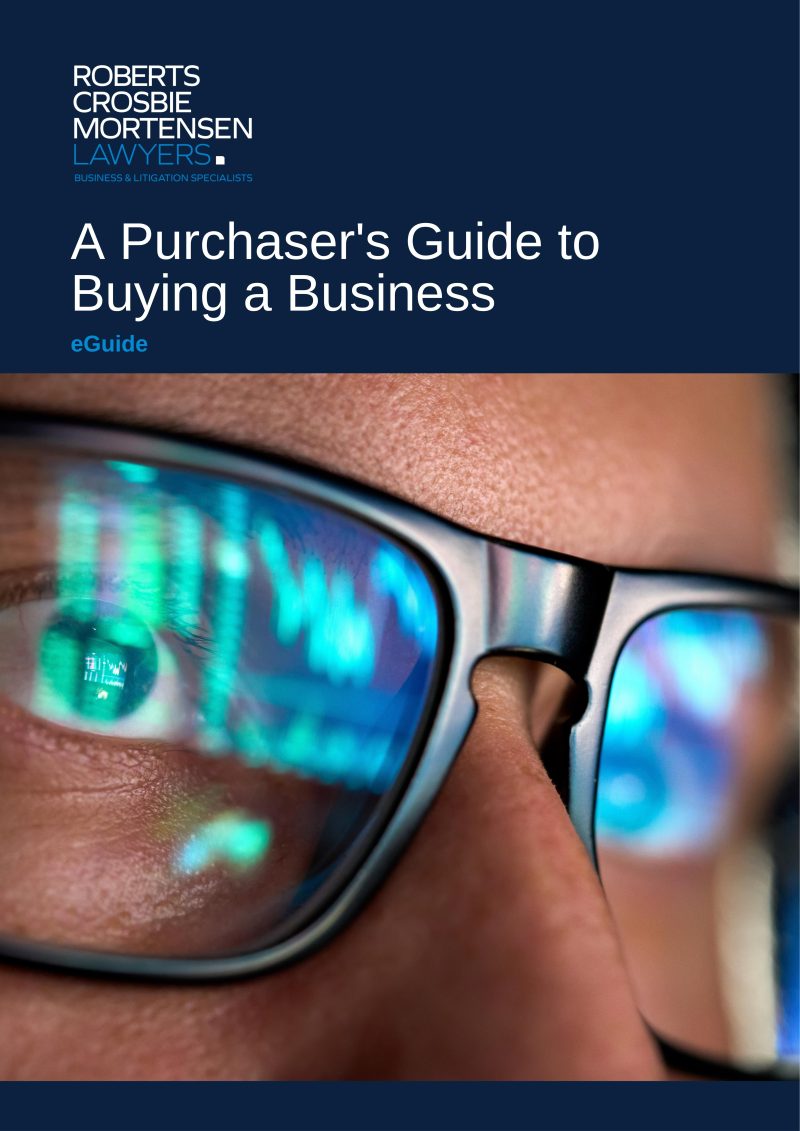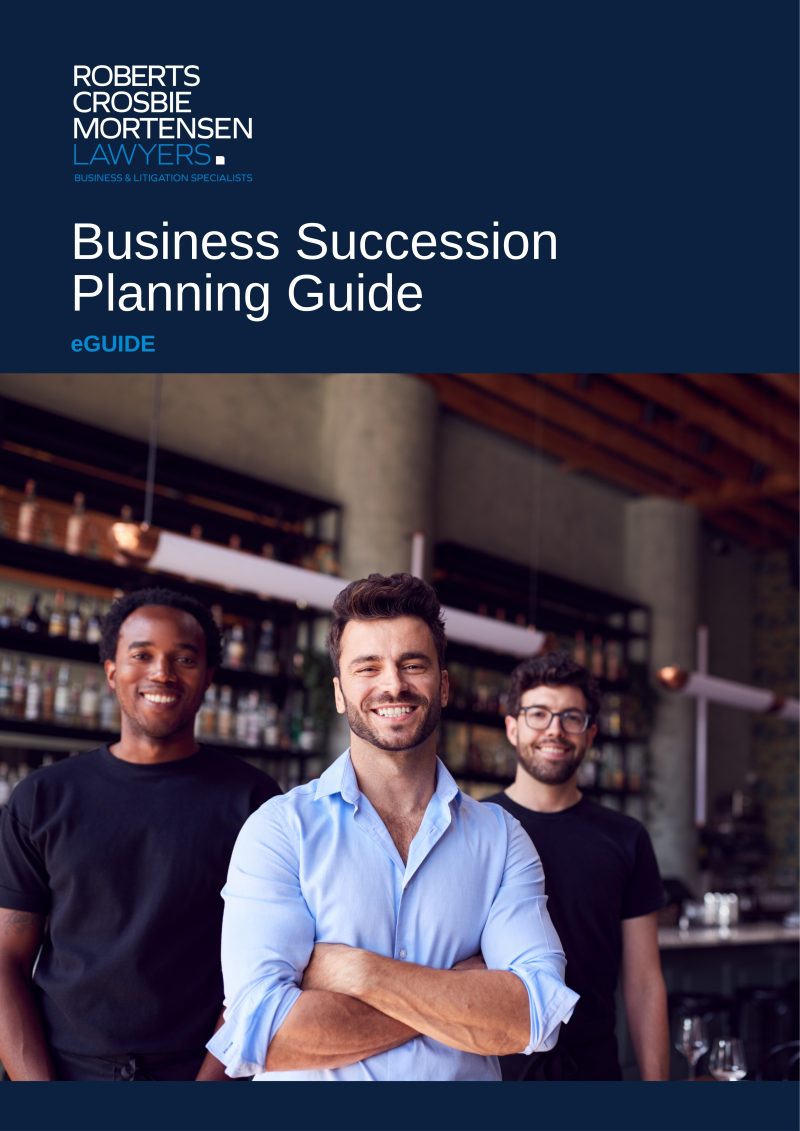What forms a Sale and Purchase Agreement for a business, is often dictated by the type or nature of the business being purchased.
An experienced business lawyer will provide advice if the business in question is of a relatively ‘standardised type’, then a ‘standardised agreement’, such as the Real Estate Institute of NSW and the Law Society of NSW standard ‘NSW Contract for the Sale of Business’ may be a good choice.
If the business being purchased is of a larger scale and/or involves a niche or complex business such as the purchase of a “rent roll business”, then a fully customised sale and purchase agreement may be necessary.
Regardless of which type of agreement is used, the following should always be considered when negotiating and preparing a sale agreement:
Purchase Price
Start with the basics. A purchase price needs to be recorded and how the purchase price is to be paid needs to be clearly stated. This is normally by way of payment in full, on the settlement date and done through the lawyers. In some case there may be vendor finance which is a loan by the Seller to the Purchaser.
Purchaser Tip
If vendor finance is offered the terms of the loan need to be considered and should be carefully documented.
Earnout or clawback clauses may be recommended to a Purchaser as a way of ensuring that the Seller is incentivised to make sure that the purchase price is fair and that the business retains its profitability following handover. Be aware if these types of clauses are to be included, they need to be properly drafted and structured.
Deposit
If, as a Purchaser, you are required to pay a deposit (which is common practice) the general rule is that it should be no more than 10% of the total purchase price and the deposit is generally held by the Seller’s business broker or the Seller’s lawyer.
Purchaser Tip
As a Purchaser always seek to have the deposit recorded as being refundable in situations where a purchase does not proceed.
Dates
Timing of the purchase needs to be agreed and a settlement date set. The parties may agree on a fixed date settlement or alternatively the settlement date may be determined by a formula based off a triggering event, often the “unconditional date” being the date all special conditions are satisfied. For example, settlement might be expressed as being the date twenty (20) business days, following the unconditional date.
Purchaser Tip
As a Purchaser make sure the proposed settlement date gives you enough time to prepare for takeover of the business and to have your funding in place.
Special Conditions
As a Purchaser it is important that you have control over certain matters and this can be achieved by the inclusion of special conditions in the agreement for sale and purchase. Special conditions (or conditions precedent) require satisfaction prior to a contract being declared unconditional and therefore binding on the parties as to settlement.
Examples of special conditions that a Purchaser may need inserted in the agreement include:
- If you are obtaining bank funding for the purchase, the agreement should be conditional on you obtaining bank finance on terms entirely satisfactory to you.
- If you have not conducted or wish to conduct further due diligence on the business, the agreement should be conditional on you being able to conclude your research on the business and being entirely satisfied with the outcome of such investigations.
- If there are any special requirements relating to the business or industry that the Purchaser needs attended to on settlement by the Seller, then these should be included as special conditions.
- If there are any consents or approvals the Purchaser requires, for example the granting of a local authority license, these should be included as a special condition.
- If a Purchaser requires certain key employees to transfer over and sign written employment agreements, this should be included as a special condition.
Landlord’s Consent
A usual special condition is that that the agreement for sale and purchase is conditional on the Seller obtaining the consent to the assignment of the lease for the business premises to the Purchaser. As part of this process you as Purchaser would normally be required to provide the landlord with information on your ability to meet the lease obligations for example your financial status.
Purchaser Tip
As part of this process the landlord may ask you for security for performance of the lease conditions by way of a bank guarantee or cash bond, which can be the equivalent of 3 months’ rent (or more).
Usual Terms
Special Conditions will deal with matters that are particular to the business or Purchasers’ circumstances. The following terms are nearly always included in a sale and purchase agreement:
- Stock: If the business you are purchasing includes the purchase of stock from the Seller, often referred to as plus SAV or PSAV then a clause around how stock is to be treated and valued needs to be included. Generally, a stock-take is always required and there is a dispute mechanism (independent valuer) to sort any differences.
Purchaser Tip
As a Purchaser you should always make sure that there is a maximum stock amount included in the agreement which means that you as Purchaser only have an obligation to buy stock up to that value (which gives you certainty when planning your finances) and that if the Seller has more stock on hand come settlement, you would generally then have the right to pick and choose what stock to buy up to the maximum stock amount.
- Conduct of the business until completion: These clauses are generally structured so that the Seller should carry on the business in a proper and businesslike way, not incurring or making material changes to the business without obtaining the Purchaser’s consent.
- Seller warranties (or promises): As a Purchaser, it is important that you get various warranties from the Seller, in particular that the business has all appropriate licenses and consents to carry on the business and that any asset of the business being sold will not be the subject to a security charge (any loan or debt).
Purchaser Tip
Obtaining warranties from a Seller is important, however, they are no substitute for conducting your own due diligence because enforcement of warranties can be a costly and difficult process.
- Training: If you as Purchaser require training by the Seller with regards to business procedures and operations it is usual for this to be agreed and recorded in the agreement. Normally it should be provided free of charge by the Seller.
- GST: Provision for GST should always be made and generally the parties record that a business is a going concern on which GST is not payable.
Purchaser Tip
Certain conditions must be met for a business to be considered by the ATO as a going concern.
- Restraints: As Purchaser you need protections that the Seller will not compete with you in your new business following settlement. This is usually done by way of inclusion of restraints given by the Seller in the agreement, or a separate Deed of Restraint of Trade. That is the Seller will not compete with the business, or entice away any employees or clients of the business within a defined territory and for a specified time frame.
Purchaser Tip
If the Seller is a company, your lawyer should also be asking for restraints from the company directors and/or shareholders.
- Adjustments to the purchase price: A mechanism is normally inserted whereby the Seller can seek from the Purchaser adjustments to the purchase price to offset payments that the Seller has made with regards to future obligations of the business. A common example being lease payments.
Purchaser Tip
Be aware and investigate what these payments could be and may amount to during your due diligence so that you are not surprised come settlement and have the funds available to meet such obligations.
- What happens on completion: As Purchaser you will be required to pay the purchase price, and in return the Seller must provide you with possession of the business assets (and clear title to those assets with no security interests being registered against them). It is therefore important that as Purchaser, you have a clear idea of what you require from the Seller to conduct the business from the settlement date.
Purchaser Tip
Practical considerations need to be considered for example keys to the business premises, security codes, website and social media passwords.
- Default: Be aware of the consequences of failing to complete on settlement (default). There are usually penalty provisions included in the sale and purchase agreement and there will be rights to terminate the agreement and recover costs.
- Lease for the business premises: If there is an existing lease in place for the business then this is normally transferred (assigned) to the Purchaser on completion. Alternatively, the Purchaser may wish to negotiate a new lease or variations to the existing lease. Either way, provisions as to how the business lease is to be treated are included in the agreement for sale and purchase, including obtaining the consent of the landlord.
Purchaser Tip
The Seller is generally responsible for paying a landlord’s costs as to an assignment of lease, however, if you as Purchaser negotiate a new lease or changes to the existing lease then as Purchaser, you may bear the landlord’s costs for doing so.
- Employees: Provisions dealing with employees will be included and as Purchaser you need to understand those obligations.
Purchaser Tip
In this Guide we have a separate section on employees (Chapter 11) which underlines the importance of understanding the transfer of employees in the purchase process.
The Sale and Purchase Agreement is the cornerstone document when it comes to the purchase of a business. Before you sign a Sale and Purchase Agreement, always have it reviewed by an experienced business lawyer.














